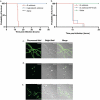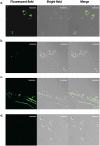Silkworm model for Bacillus anthracis infection and virulence determination
- PMID: 34490836
- PMCID: PMC8425766
- DOI: 10.1080/21505594.2021.1965830
Silkworm model for Bacillus anthracis infection and virulence determination
Abstract
Bacillus anthracis is an obligate pathogen and a causative agent of anthrax. Its major virulence factors are plasmid-coded; however, recent studies have revealed chromosome-encoded virulence factors, indicating that the current understanding of its virulence mechanism is elusive and needs further investigation. In this study, we established a silkworm (Bombyx mori) infection model of B. anthracis. We showed that silkworms were killed by B. anthracis Sterne and cured of the infection when administered with antibiotics. We quantitatively determined the lethal dose of the bacteria that kills 50% larvae and effective doses of antibiotics that cure 50% infected larvae. Furthermore, we demonstrated that B. anthracis mutants with disruption in virulence genes such as pagA, lef, and atxA had attenuated silkworm-killing ability and reduced colonization in silkworm hemolymph. The silkworm infection model established in this study can be utilized in large-scale infection experiments to identify novel virulence determinants and develop novel therapeutic options against B. anthracis infections.
Keywords: Bacillus anthracis; animal model; bombyx mori; host-pathogen interaction; silkworm; virulence.
Conflict of interest statement
No potential conflict of interest was reported by the authors.
Figures





Similar articles
-
Bacillus anthracis Virulence Regulator AtxA Binds Specifically to the pagA Promoter Region.J Bacteriol. 2019 Nov 5;201(23):e00569-19. doi: 10.1128/JB.00569-19. Print 2019 Dec 1. J Bacteriol. 2019. PMID: 31570528 Free PMC article.
-
ClpX contributes to innate defense peptide resistance and virulence phenotypes of Bacillus anthracis.J Innate Immun. 2009;1(5):494-506. doi: 10.1159/000225955. Epub 2009 Jun 18. J Innate Immun. 2009. PMID: 20375606 Free PMC article.
-
Bacillus cereus G9241 makes anthrax toxin and capsule like highly virulent B. anthracis Ames but behaves like attenuated toxigenic nonencapsulated B. anthracis Sterne in rabbits and mice.Infect Immun. 2011 Aug;79(8):3012-9. doi: 10.1128/IAI.00205-11. Epub 2011 May 16. Infect Immun. 2011. PMID: 21576337 Free PMC article.
-
Bacillus anthracis genetics and virulence gene regulation.Curr Top Microbiol Immunol. 2002;271:143-64. doi: 10.1007/978-3-662-05767-4_7. Curr Top Microbiol Immunol. 2002. PMID: 12224521 Review.
-
Recent Developments in Anti-dotes Against Anthrax.Recent Pat Antiinfect Drug Discov. 2014;9(2):83-96. doi: 10.2174/1574891x09666140830213925. Recent Pat Antiinfect Drug Discov. 2014. PMID: 25174439 Review.
Cited by
-
Applications and Potentials of a Silk Fibroin Nanoparticle Delivery System in Animal Husbandry.Animals (Basel). 2024 Feb 19;14(4):655. doi: 10.3390/ani14040655. Animals (Basel). 2024. PMID: 38396623 Free PMC article. Review.
-
Silkworm model of bacterial infection facilitates the identification of lysocin E, a potent, ultra-rapid bactericidal antibiotic.J Antibiot (Tokyo). 2024 Aug;77(8):477-485. doi: 10.1038/s41429-024-00739-x. Epub 2024 May 21. J Antibiot (Tokyo). 2024. PMID: 38773231 Review.
-
Pleiotropic functions of CpdB in Bacillus anthracis.World J Microbiol Biotechnol. 2025 Apr 28;41(5):143. doi: 10.1007/s11274-025-04353-3. World J Microbiol Biotechnol. 2025. PMID: 40289237
-
Alternatives to animal models to study bacterial infections.Folia Microbiol (Praha). 2023 Oct;68(5):703-739. doi: 10.1007/s12223-023-01084-6. Epub 2023 Aug 26. Folia Microbiol (Praha). 2023. PMID: 37632640 Review.
References
-
- Fritze D.Taxonomy of the genus Bacillus and related genera: the aerobic endospore-forming bacteria. Phytopathology. 2004;94(11):1245–1248. - PubMed
-
- Hang’ombe MB, Mwansa JC, Muwowo S, et al. Human-animal anthrax outbreak in the Luangwa valley of Zambia in 2011. Trop Doct. 2012;42(3):136–139. - PubMed
Publication types
MeSH terms
Substances
LinkOut - more resources
Full Text Sources
Medical
Miscellaneous
